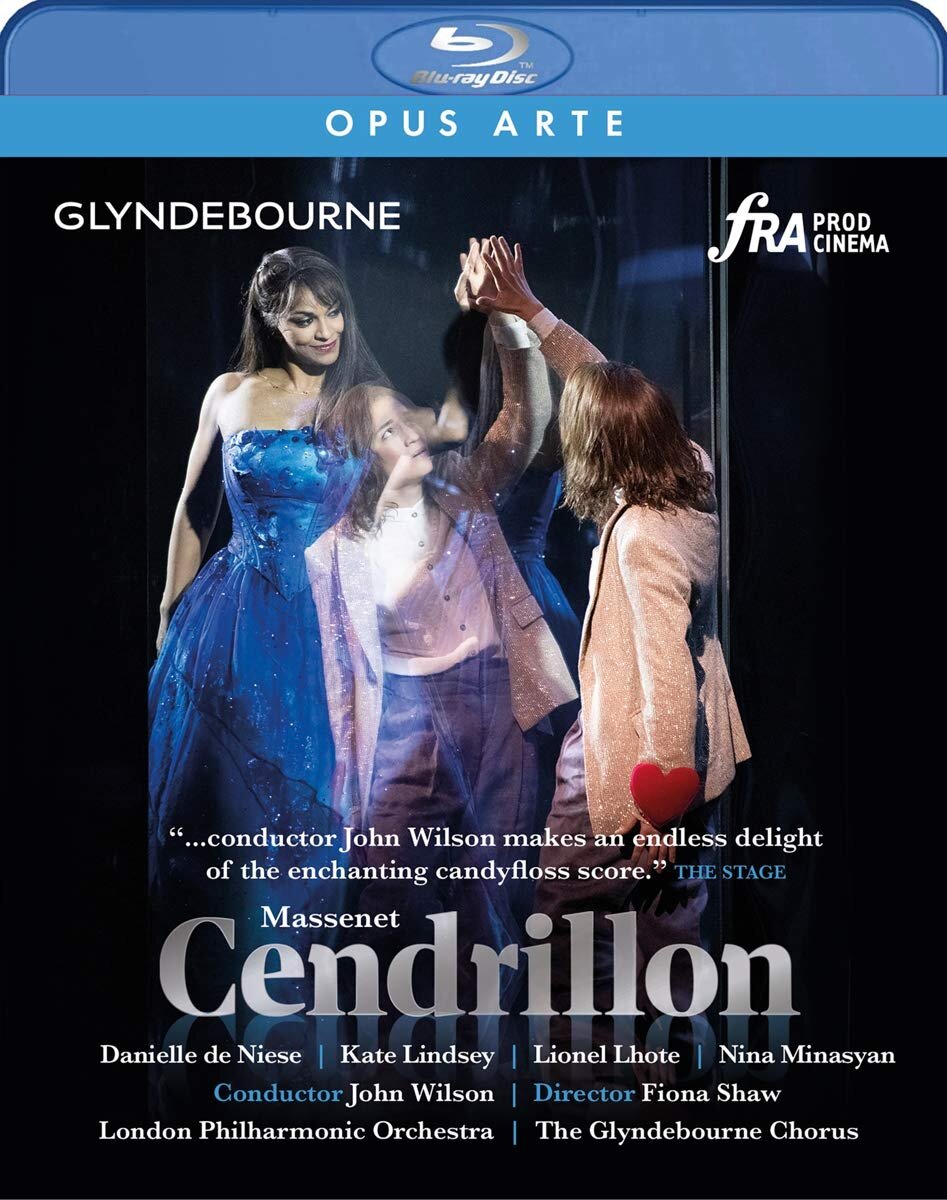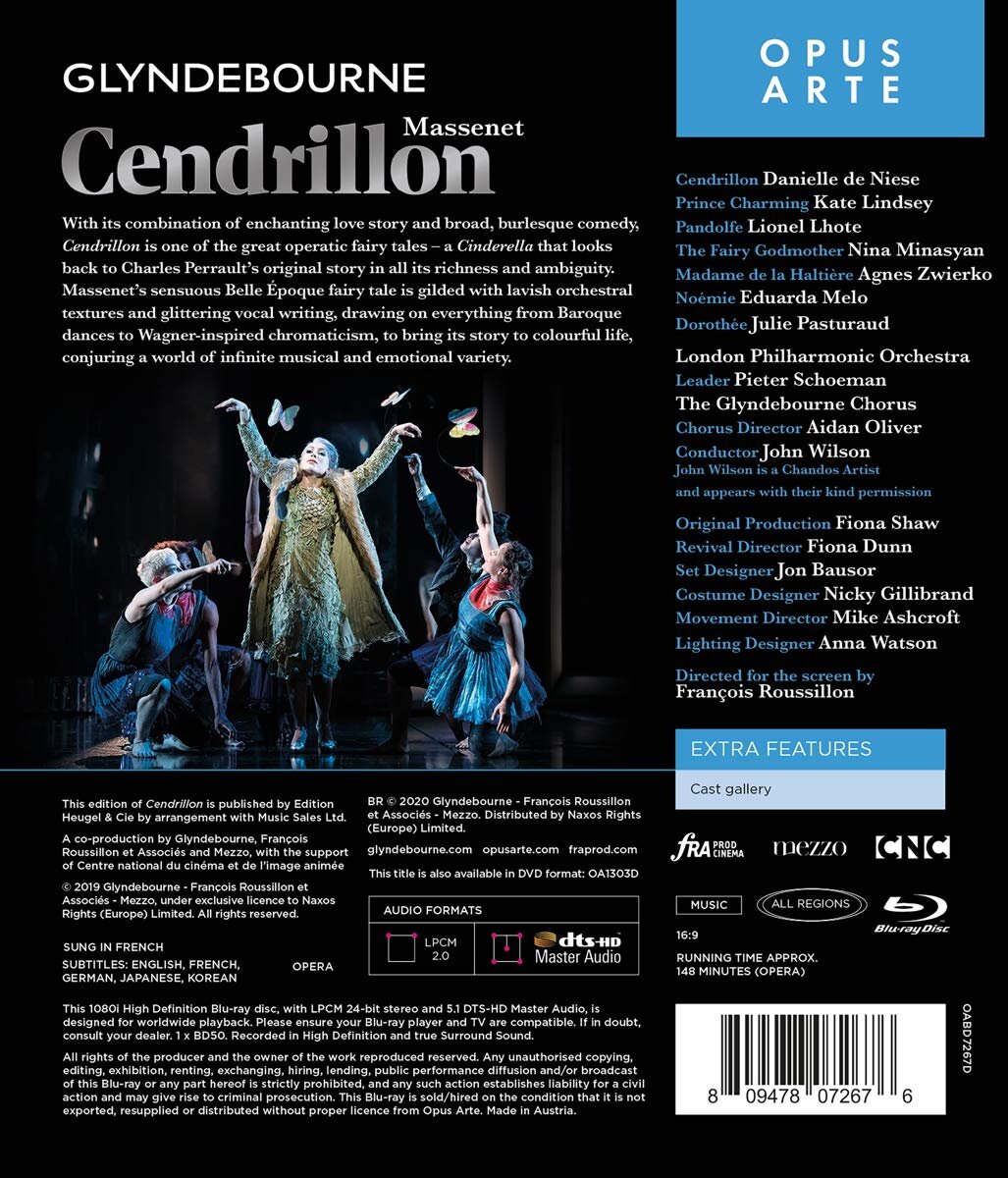

Massenet Cendrillon (Cinderella) opera to a libretto by Henri Caïn. Directed 2019 at Glyndebourne by revival director Fiona Dunn after Fiona Shaw. Stars Danielle de Niese (Cendrillon), Kate Lindsey (Prince Charming), Lionel Lhote (Pandolfe), Nina Minasyan (The Fairy Godmother), Agnes Zwierko (Madame de la Haltière), Eduarda Melo (Noémie), Julie Pasturaud (Dorothée), Romanas Kudriašovas (Master of Ceremonies), Anthony Osborne (The Dean), Michael Wallace (The Prime Minister), Adam Marsden (The King), Sofia Larsson (First Spirit), Jacquelyn Parker (Second Spirit), Jennifer Witton (Third Spirit), Leslie Davis (Fourth Spirit), Rhiain Taylor (Fifth Spirit), Lauren Easton (Sixth Spirit). Also features Megan Silburn (Little Cinderella [mute]), Richard Bignall, Natalia Brzezińska, Sam Carl, Andrew Davies, Jade Moffat, David Shaw, Rachel Taylor, and Pamela Wilcock (Servants) as well as dancers Jess Barlow, Ryan Munroe, Emily Pottage, Sophie Thorpe, and Connor Williams. John Wilson conducts the London Philharmonic Orchestra (Leader Pieter Schoeman) and the Glyndebourne Chorus (Chorus Director Aiden Oliver). Set design by Jon Bausor; costume design by Nicky Gillibrand; lighting design by Anna Watson; and movement direction by Mike Ashcroft. Directed for TV by François Roussillon. Sung in French. Released 2020, disc has 5.1 HD Master Audio sound. Grade: A
In the heart of every child burns the existential question: “What will I become?” The child is fascinated by the repulsive worm that becomes the beautiful butterfly. The child loves the stories of the ugly duckling that becomes a swan and the abandoned Cinderella who is saved from a wretched life by her merit and good fortune. In the past there have been many variations of Cindy’s story to fit the needs of changing times.
The ancient fairy tale was dreamed up for children; Massenet’s opera was written for adults. According to Rodney Milnes writing in The Grove Book of Operas (2nd Edition, page 115), Massenet wrote the part of the Prince for a mezzo in pants as part of his treatment of Cendrillon and the Prince as “lost, desperate children” who save each other. That was 130 years ago. So get ready for this new Glyndebourne version of Cindy’s story. Now the mezzo in pants aspect gets a completely new twist, inspired by what we are learning in our time about the mysteries of sexual identity and affinity.
In a kind of prologue, we briefly meet below the young Cindy (Megan Silburn in mute role), her mother (Nina Minasyan), and her father Pandolfe (Lionel Lhote).
Cindy is fascinated with butterflies, which pop up in the design of this production at every possible opportunity:
Now fast forward. Mother died. Pandolfe, hoping to improve his finances, moved from his farm and forests to the city to marry a titled widow with 2 titled daughters. Cindy (Danielle de Niese) has been relegated to the status of a servant. Here she collects bags of clothing bought by her stepmother and stepsisters on a shopping spree. Behind Cindy is an actual servant girl (Kate Lindsey) who is a special but never-named friend of Cindy’s. Cindy’s friend remains mute until about 5 minutes before the end of the opera, because she doesn’t exist in Massenet’s libretto. Here the friend is aghast at the amount of money Cindy’s steps are spending:
Pandolfe, still crushed by the loss of his first wife, knows exactly what is happening but has been to weak to protect Cindy:
Now stepmom Haltière (Agnes Zwierko), stepsister Noémie (Edwarda Melo) and stepsister Dorothée (Julie Pasturaud) are putting on their new clothes to go to the King’s ball in honor of the Prince, who, so rumor has it, is looking for a wife and future Queen. The steps practice how they will talk to the Prince and direct Cindy’s friend to play the part of the Prince. They decorate Cindy’s friend with a “bleeding heart” (which is really a pin cushion Cindy’s friend uses in her work) and crown her with a shopping bag. Everything you see in this image would be funny and appropriate in the typical Cinderella production. But this opera is not a comedy and the antics of the steps here are overacted and fall flat as stereotypes. Still, the image is important as it will have a big impact on the dream of the Prince that Cindy will have later. (BTY: Madame de la Haltière in French translates into English as “Mrs. Dumbbell”):
And now the house is quiet after the steps have left for the ball. Cindy laments and goes to sleep on the floor next to the fire. We then move from real life into Cindy’s 1st dream:
Next below, Cindy dreams her real mother appears as the Fairy Godmother. Massenet gives Godmother a coloratura part that’s right up there with Mozart’s Queen of the Night or Strauss’s Zerbinetta in my flabbergasted estimation. And she is so sexy in comparison to the other characters we have met so far. Note the cigarette in her hand. Many of the characters in this show hold cigarettes, but there’s almost no smoke. Why use this prop? Maybe this is just to remind us that Cindy cleaned up the ashes from all the household fires. Or maybe the designer wanted the cigarettes and other props to place the story in England in the first half of the 20th century. (In the keepcase notes, revival director Fiona Shaw says that ashes=carbon, which can emerge in the form of a diamond. Fiona needs to take a chemistry course. Carbon is one of the elements that combines quickly with oxygen and this is usually the essence of what we call a fire. A diamond is a crystal of carbon. If you heat up your diamond engagement ring, it will catch fire and disappear quickly in a puff of black smoke. Ashes are typically everything left by the fire after the carbon has disappeared. So ashes don’t yield diamonds.)
Spirits 1 through 6 and helper sprites conjure up a wonderful outfit for Cindy to wear to the ball. The high-heel-shoe hats, a gimmick we first saw in the 2013 Glyndebourne production of Ariadne auf Naxos, is now a bit shopworn. But using the clothes storage bag as a cocoon for a pupa named Cindy may be an original stroke:
I forget to mention that the real-life name for our Cendrillon is “Lucette”, which means, of course, “little light”. She only became Cendrillon after she moved into the home of Madame de la Haltière. To avoid confusion, I’ll keep calling her Cindy:
Now Cindy’s dream moves on to royal palace where the prince is being examined as part of his treatment for melancholy. (This will seem familiar to anyone who remembers the prince in Prokofiev’s Love for Three Oranges.) Cindy is now the operating room nurse assisting the Dean of the Medical School (Anthony Osborne). You don’t often see surgeons smoking in the operating room:
The medical team removes the Prince’s heart, which looks exactly like the plush pin cushion heart we last saw on Cindy’s friend. They sew the heart to the left sleeve of the Prince’s glitter-jacket. After recovery, the Prince does a pretty good imitation of Michael Jackson. Do you recognize the Prince? Why, he’s Kate Lindsey in trousers! So here we have a mezzo playing a female part and a different male roll (in breeches) in the same opera. Is this a first?
After examination by the Dean, the Prince agrees to go to the party the King has arranged in the Prince’s honor. Below the guests are playing musical chairs. The walls consist of four giant prisms with fancy LED lighting:
The Prince arrives and sees Cindy as an apparition inside one of the prisms. For a better view of this scene, see the artwork on front of the keepcase or the YouTube clip below with the pin cushion heart clearly visible:
Was the line below dreamed up by librettist Henri Caïn, or has it been around for centuries? If it was original to Caïn, is it the most famous line in all opera?
Earlier I suggested this is dated to about, say, 1935. But management could not resist making the prisms into a digital clock, which probably didn’t exist until much later. Cindy and the Prince are madly in love, and the dream has exactly one second left to last on the 24-hour clock:
The 1st dream is over:
The steps have returned home from the ball and report on a strange disaster that ruined the party:
In a touching scene, Pandolfe announces his decision to leave the city with Cindy and return to their farm. Cindy doesn’t think her father can make it now on the farm at his age. She runs away to die alone. In a 2nd dream Godmother saves the day again by bringing Cindy and the Prince together in a secret bower near a magic lake. And that’s where Pandolfe finds Cindy later nearly dead:
Finally, Cindy awakes and finds the pin cushion heart in her room:
Cindy still needs bedrest to recover and think. Thanks to terrific acting from De Niese, we Cindy starting to figure things out:
Which leads to Cindy’s 3rd dream. Now the Prince appears once more but in the female form of Cindy’s friend in her servant’s skirt. Five minutes before the end of the opera, Cindy’s friend finally sings—about the shoe left behind at the party. These are, of course, the words Massenet originally gave to his mezzo in trousers:
And the opera ends with Cindy is still in her 3rd dream. But we know that when she awakes this time, she will finally know who she is and what it is that she wants. And if neither Cindy nor her Prince has died, they are still enjoying their lives together.
So here, my friends, we have a completely new vision of the Cendrillon story that’s totally appropriate and works pretty well in today’s social environment embracing ABC to XYZ. Getting from the traditional fairy story to this Glyndebourne conclusion would be too much, obviously, for little kids or for opera fans interested only in traditional productions. And even with the best of will, most opera fans will have to watch this several times to see how it all fits together. With great singing and acting by all, beautiful playing of Massenet’s intriguing score, fine videography by Roussillon, and excellent SQ/PQ, this production is worth the effort.
Now to a grade. Starting with A+ I reduce this to A- for being overly cluttered with different images and ideas. Maybe some editing would have helped the viewer to focus on the non-binary twist that makes this production so clever. Thanks to that cleverness, I’ll put the grade up to A. If this review resonates with you personally, you will probably view this as an A+ title.
Here’s a trailer from Glyndebourne
OR























